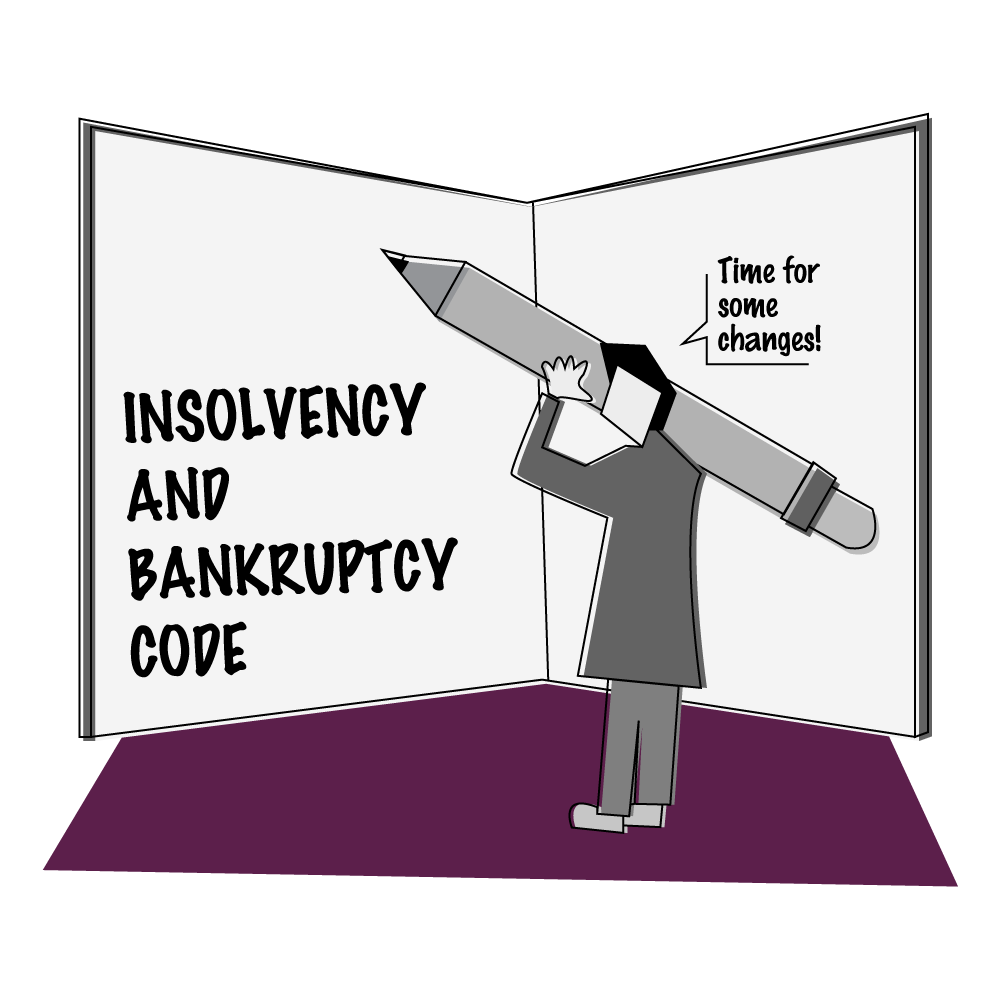IBC Amendments: Value Maximization

Recently
In September 2022, the Insolvency and Bankruptcy Board of India (IBBI) – the Board governing the IBC issued notifications containing a series of amendments to various aspects of Insolvency and Bankruptcy Code (IBC)
- IBBI (Insolvency Resolution Process for Corporate Persons) (Fourth Amendment) Regulations, 2022,
- IBBI (Liquidation Process) (Second Amendment) Regulations, 2022 and
- IBBI (Voluntary Liquidation Process) (Second Amendment) Regulations, 2022
An insight into key amendments:
IBBI (Insolvency Resolution Process for Corporate Persons) (Fourth Amendment) Regulations, 2022
Effective date: 16.09.2022
Regulation
Particulars
Amendment (in bullet points)
4C
Process e-mail
- An interim resolution professional shall open an e-mail and use it for all correspondence with stakeholders.
- If the interim resolution professional (IRP)is being replaced with another IRP or liquidator, then the former shall hand over e-mail credentials to the latter.
6A
Communication to creditors
- The IRP shall send communication about the CIRP process to all creditors along with a copy of public announcement as per last available books of accounts of the corporate debtor either through post or e-mail.
- If communication is not possible either through post or e-mail, the public announcement made shall be deemed to be the communication to the creditors
Explanation to 18(2)
Meetings of the COC
- The resolution professional may convene meeting of the COC of creditors (COC) whenever he thinks necessary or on receipt of request of not less than 33% of members of the COC with voting rights;
- The explanation has been amended to clarify that such meetings may be convened till the resolution plan has been approved or liquidation order is passed and decide on matters which do not affect the resolution plan submitted before the Adjudicating authority.
35A (3) & 35A (3A)
Preferential and other transactions (undervalued, fraudulent & extortionate) ‘PUFE’ transactions
On and from 65 days of commencement of insolvency the resolution professional (RP) shall determine preferential transactions as per regulations 43,45,50 or 66 of the IBC within 115 days. Thereafter he must proceed to apply to the Adjudicating authority (AA) for relief within 135 days of the insolvency commencement date.
- The amendment has reduced the time period of applying to the AA from 135 days to 130 days
- Further the RP shall forward a copy of the application (that he made to the AA) to the prospective resolution applicant to enable him to consider the same while submitting the resolution plan within the time initially stipulated.
36
Information Memorandum (IM)
The RP should submit an information memorandum (IM) in e-mail to each member of the COC within 2 weeks or his appointment but not later than 45 days of the insolvency commencement date, whichever is earlier
- The timeline for submission has been amended. IM can now be submitted within 95 days from the insolvency commencement date.
- Content of the IM has been amended to serve as comprehensive document highlighting key selling propositions and all relevant information of the corporate debtor (CD) such as operational, financial and other information.
- Amendment in Financial statements have been introduced to include details of contingent liabilities and geographical co-ordinates of fixed assets besides other details.
- Other details to be included such as details of business evolution, industry overview and key growth drivers in case of a corporate debtor having book value of total assets exceeding one hundred crores rupees as per the last available financial statements.
- Details of business evolution, industry overview and key growth drivers in case of a corporate debtor having book value of total assets exceeding one hundred crores rupees as per the last available financial statements.
36A
Invitation for expression of interest
RP shall publish invitation for expression of interest in Form G not later than 75 days from date of insolvency commencement date.
- The timeline has been reduced (from 75 days) to 60 days from date of insolvency commencement date.
36B
New sub clause (6A) introduced
Request for resolution plan
- If the RP does not receive resolution plan in response to his request, then, with the approval of the COC, the RP may issue request for resolution plan for sale of one or more assets of the corporate debtor.
36C
Strategy for marketing assets of the corporate debtor
- Where the total assets of the corporate debtor exceed 100 Crores, the RP, may in consultation with the COC prepare a strategy for marketing the assets of the CD. The decision of implementation of the strategy along with cost and marketing of assets may be determined by the COC.
37
New clause (m) introduced
Resolution plan
A resolution plan shall provide for the measures necessary, for insolvency resolution of the CD towards maximization of value of its assets, including but not limited to certain measures:
- Sale of one or more assets of the CD to one or more successful resolution applicants and manner of dealing with remaining assets
39BA New clause introduced
Assessment of compromise or arrangement
In deciding on whether to liquidate the corporate debtor, the COC shall explore the possibility of compromise or arrangement and submit the same to the AA. The options shall be explored when the submission is pending before the AA.
40A
Model timeline for CIRP
The amended timeline has been included in the model timeline for CIRP
Schedule I
Forms G
Introduced
New Regulation 40D with Sub Regulations (1) & (2)
Decision for liquidation
In deciding on liquidation of the corporate debtor, the COC must consider the non-operational status for the preceding 3 years, goods produced, or services offered or technology employed obsolete, absence of any lack of assets, lack of any intangible assets or factors or bringing the value of assets over and above the physical assets like brand value, IP, accumulated losses, depreciation etc. the same has to be submitted / informed to AA by the RP.
Schedule I
Forms G
Introduced
Schedule II
Fee structure
Introduced
IBBI (Liquidation Process) (Second Amendment) Regulations, 2022
Effective date: 16.09.2022
Regulation
Particulars
Amendment (in bullet points)
2B New proviso (1) introduced
Compromise or arrangement
Where a compromise or arrangement is proposed under section 230 of the Companies Act 2013, it shall be completed within 90 days of order of liquidation.
- Where the COC makes the recommendation to explore the proposal of compromise or arrangement, the liquidator shall file such proposal within 30 days of the order of liquidation.
Regulation (1A) introduced
Liquidator’s fee
The fee payable to a liquidator shall form part of the liquidation costs
- When no fee has been fixed, the stakeholder’s consultation committee may fix fee of the liquidator in its first meeting.
12 (2) Sub regulation (c) introduced
Public announcement by liquidator
The liquidator shall make public announcement in the prescribed Form (Form B of Schedule II) within 5 days from the date of his appointment calling upon stakeholders to submit or update their claims.
- Where a stakeholder does not submit such claims during the liquidation process, claims submitted by such a stakeholder and duly collated by an IRP during the CIRP process shall be deemed to be submitted under section 38
12A New clause introduced
Process e-mail
The liquidator shall operate the e-mail id handed over to him by the IRP. In the event of his replacement, credentials of such e-mail shall be handed over to the new liquidator.
15 (1) (4)
Progress reports
- The liquidator shall submit progress reports in the format stipulated by the IBBI within the prescribed timeline.
- Sub clause (4) has been deleted – pertaining to accessibility of progress report containing statement of material changes unless permitted by AA
30 Proviso introduced
Verification of claims
The liquidator shall verify claims submitted within 30 days from the last date of receipt
- Provided the liquidator shall also collate claims submitted during CIRP and not liquidation process within 30 days from last date for receipt of claims during liquidation process and either accept or reject them in whole or part.
31A
1A
(2)
(3)
(4A)
6
10
11
Stakeholders’ consultation committee
- The liquidator shall constitute a stakeholder’s consultation committee comprising a creditors of the CD within 60 days from the liquidation commencement date to advise on matters relating to
Remuneration of professionals appointed,
Manner of sale, sale, marketing strategy, liquidator fee, valuation, PUEF etc
- The COC shall function as the consultation committee
- The voting share of member of the consultation committee shall be proportionate to his claim admitted in the total claim admitted. Provided that secured creditor and related party of the CD may attend the meeting but not vote.
- The liquidator may facilitate nomination oof representative of each class of financial creditor – workmen, employees, government departments and other operational creditors, shareholders etc
- Such representative shall vote in proportion to the voting share of stakeholder it represents.
- The liquidator shall convene the first meeting within 7 days of liquidation commencement date. He may convene other meetings on receipt of request from one or more members. Provided that the liquidator shall mandatorily convene the meeting if request is received from members individually or collectively holding 30% voting right.
- The liquidator is not bound by advice of the consultation committee. If liquidator’s decision is different from the committee’s than he shall record reasons in writing and submit to the AA within 5 days of the said decision.
- The consultation committee may by a majority 66% vote replace the liquidator. Provided where the consultation committee was constituted prior to these amendments, the liquidator shall within 30 days of the amendments reconstitute the committee.
32A
(4)
Sale as a going concern
Where the COC recommends the sale or the liquidator is of the opinion that sale will maximize the value of the CD, then the liquidator shall first endeavour to sell the assets of the CD as a going concern. The COC shall identify such assets for sale as going concern.
- The Liquidator may sell such assets exclusively in the first auction
32B
Meetings of the Consultation committee
The regulations for conduct of meetings shall apply as it is to meetings of consultation committee under liquidation proceedings.
34
(1) & (1A)
(5)
Asset Memorandum
The liquidator shall prepare an asset memorandum within 75 days from the liquidation commencement date.
- The timeline has been reduced (from 75 days) to 30 days from liquidation commencement date. For other cases, it shall be 75 days.
- Confidentiality of the asset memorandum shall be maintained
44
Completion of liquidation
The liquidator shall complete liquidation process within 1 year from liquidation commencement date.
- the additional period of 90 days for sale of assets in certain cases has been deleted.
44A
Treatment of avoidance transactions
On the advice of the consultation committee, the liquidator shall file an application along with the final report indicating the treatment of PUEF transactions
47
Model timeline for liquidation
The amended timeline has been included in the model timeline for liquidation
Schedule I
Mode of sale
The timeline for inviting auction, completing it has been laid down in the schedule
- Issue public notice for auction sale: within 45 days from liquidation commencement date
- Public notice for second auction if first fails: within 15 days from last failed auction
- Completion of auction process: within 35 days form issue of public auction notice
- Submission of documents by prospective bidder: at least 14 days from public auction notice
- Inspection or due diligence of assets by qualified bidder: at least 7 days
- Deposit of EMD by prospective bidder: at least up to 2 days before date of auction
Liquidator shall sell assets only through e-platforms empanelled by the Board from a date to be notified by the Board
Form AA
New form introduced for written consent to act as liquidator
IBBI (Voluntary Liquidation Process) (Second Amendment) Regulations, 2022
Effective date: 16.09.2022
Regulation
Particulars
Amendment (in bullet points)
3(5)
Initiation of liquidation
Liquidation proceedings must be undertaken subject to compliance of certain conditions.
- The declaration required under regulation 59(3)(a) that the corporate person has made provision for preservation of its records after its dissolution
41
Preservation of records
The Regulation has been widened to include preservation of copies of several documents
a) his appointment as liquidator, including the terms of appointment;
b) handing over / taking over of the assignment;
c) initiation of voluntary liquidation process;
d) public announcement;
e) claims, verification of claims, and list of stakeholders;
f) engagement of professionals, registered valuers, etc. including work done, reports etc., submitted by them;
g) all filings with the Adjudicating Authority, Appellate Authority, High Courts, Supreme Court, whichever applicable and their orders;
h) statutory filings with Board and insolvency professional agencies;
i) correspondence during the voluntary liquidation process;
j) cost of voluntary liquidation process;
k) all reports, registers, documents such as preliminary report, annual status report, final report prior to dissolution, various registers and books, etc. mentioned in Regulation 8 and 10 of principal regulations; and
l) any other records, which is required to give a complete account of the process.
electronic copy of all records (physical and electronic) for a minimum period of 8 years; and a physical copy of records for a minimum period of 3 years from the date of dissolution of the corporate person, before the Board, the AA, Appellate authority or any Court, whichever is later. Records shall be preserved at a secured place and be handed over in case of replacement of liquidator. The manner of preservation shall be intimated to the AA.
Conclusion
The various amendments have one objective – Maximization of value in resolution. From allowing the COC and RP to sell of one or more asset of the CD when there are no effective resolution plans for the CD, to streamlining timelines and laying down fee structure for liquidators, the amendments have been welcomed as the need of the hour.

